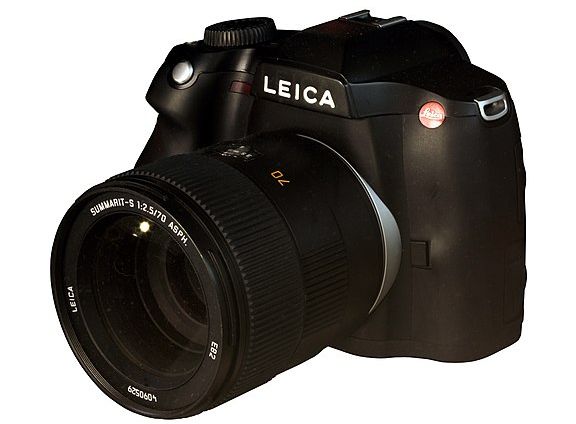
The image above is from the Wikimedia Commons, licensed under the Creative Commons Attribution-Share Alike 2.0 France License, and is thus available for your use under the same terms.
Its author is Rama.
The principle of a single-lens reflex camera, of course, does not at all depend on the size of film it uses; after all, earlier in these pages, we saw how the first single-lens reflex cameras used larger formats of film before the Kine Exakta came along.
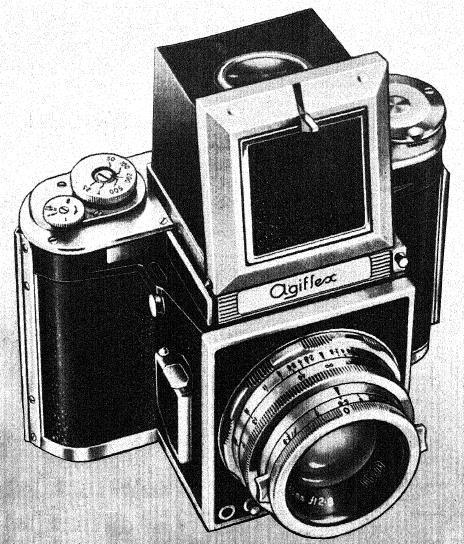
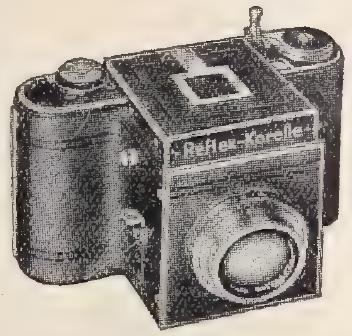
The Agiflex dates from 1946; the company that made it had been making basically the same camera during World War II for the use of the British armed forces. It was said to strongly resemble the Reflex Korelle from Germany, but it did not attempt to be an exact copy; I managed to find an image of that camera, which is shown at right, from a British photography magazine from 1936. It took square photographs in the 6x6 format.
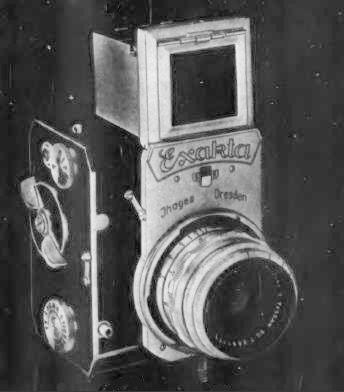
In 1955, the Exakta 66, shown at right, was introduced, so the company that began making SLRs with 127 film returned to medium format photography. An Exakta 66 III, considerably different in appearance, was still being sold in the 1990s.
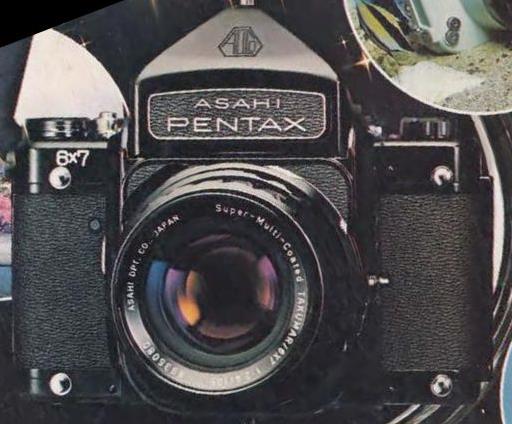
Shown at left is the Pentax 6x7, which dates from 1969. It uses 120 roll film, but in design it strongly resembles a typical 35mm SLR, including the pentaprism.
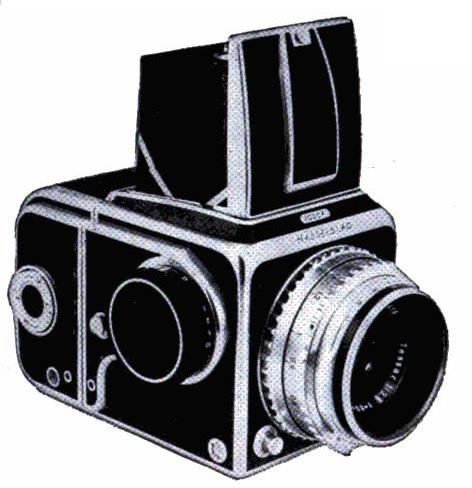
At left here is the Hasselblad 1000F, a large format camera which is greatly renowned. It was introduced in 1957. Later models, with different numerical designations, such as the 500C and the 500C/M, were very similar in appearance.
This camera used leaf shutters in its lenses. (And so, at this point, one almost hears the voice of Kodak, proclaiming that its choice of using such a shutter in the Retina Reflex is vindicated.) As is obvious from the photo at left, it eschews a pentaprism, just having a waist-level finder. However, if you really want to take photographs while looking forwards, the PM-90 and PME-90 (the latter including exposure metering) are available as accessories for the Hasselblad 500C to add a pentaprism. There are also accessory 45 degree finders to allow a viewing angle intermediate between that of looking down or looking forwards.
The standard back for the camera carries 120 roll film, but backs which use other types of film are also available for the Hasselblad; it can be made to use Polaroid film, and later in its life a digital back was introduced.
The Hasselblad was used by astronauts on the Apollo moon missions, and other early NASA space missions. It is perhaps best known, however, as the preferred choice for fashion photography, and studio photography in general.
Interestingly enough, when the Hasselblad 1000F was first offered for sale, while it was available with an f/4 Zeiss lens, its choice for an f/2.8 lens was a Kodak Ektar. The 80mm f/2.8 Kodak Ektar was also offered for the earlier 1600F, with a 135mm Ektar and a 250mm Zeiss Opton Sonnar as additional interchangeable lenses for the camera.
The earliest models of the Hasselblad camera, the 1000F and 1600F, had a focal-plane shutter, while the 500C and later models used a leaf shutter in the lens. This change was, of course, accompanied by a change in the lens mount, which was no doubt frustrating to early adopters of the Hasselblad.
The Hasselblad 1600F was the initial model of Hasselblad camera, and it only recieved a model designation after one was needed to differentiate it from the 1000F. It was announced in October 1948, but only became available, in limited quantities, in March 1949, at least in the United States. The first Swedish-language brochure for the Hasselblad also dates from 1949.
The firm now known as Hasselblad was previously known as Ross. The Ross HK-7, a medium-format camera incorporating some of the features of the later Hasselblad cameras, was used by the Swedish air force, and sold by neutral Sweden both to Britain and to Germany during World War II. Among the pictures taken with it were photographs documenting the early wartime development of rocketry.
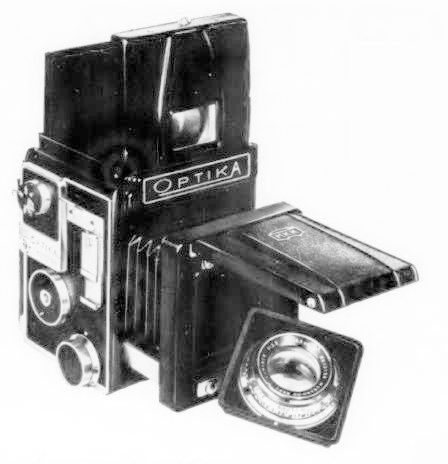
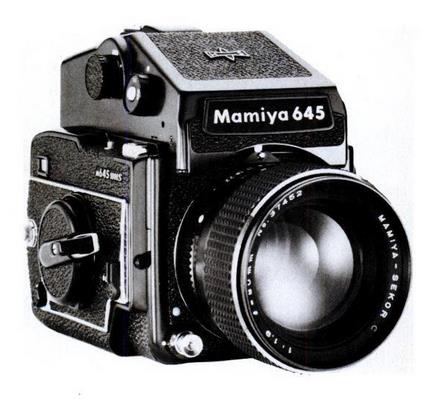
Pictured at left is the Mamiya 645-1000S.
Several companies made cameras which directly competed with the Hasselblad; there was a competitor from Mamiya, and there was the Bronica camera. Other companies still took a different approach to the medium-format SLR. One example was Pentax, with their Pentax 6x7 that looked like a larger version of a 35mm SLR, which we saw above. On the other hand, in 1961, the Japanese company Musahino sold a camera in Japan as the Rittreck IIa, which was called the Optika IIa for export. This camera is pictured at right.
The lenses for it were mounted on lensboards that were interchangeable, and the lensboards were moved on a bellows to focus. An assortment of six different focal lengths of lens was offered, but no wide-angle lenses were among the options available.
So in those aspects, it resembled a view camera; but it had interchangeable backs for different types of film and sizes of image, and it was a single-lens reflex with a reflex mirror inside and a waist-level finder, and so in those aspects it competed with the Hasselblad.
Presumably, being old-fashioned in front let it be sold at a lower price, thus making it of interest to some photographers, but it seems not to have been all that popular.
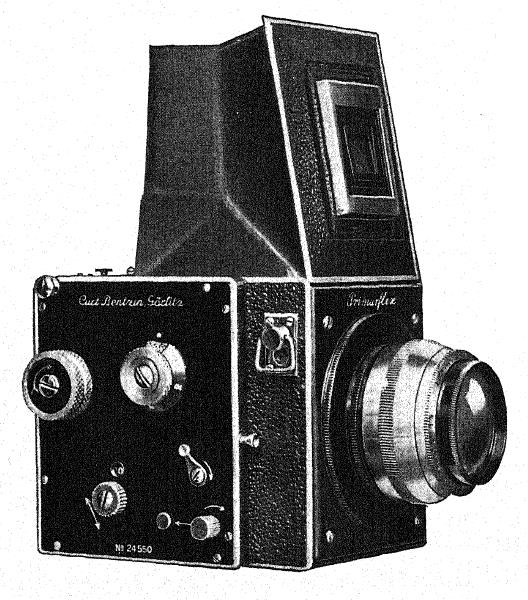
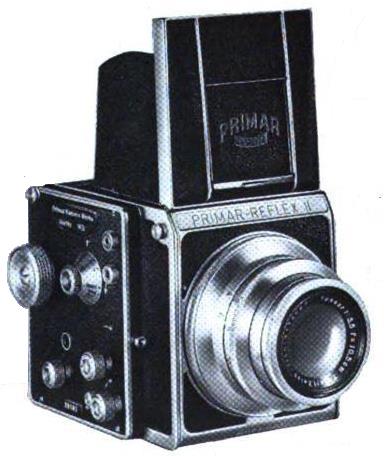
Bentzin, the company that made the uniquely compact Primarette camera we saw earlier, also made the Primarflex camera shown at left. This image is from a 1937 advertisement, so like many other medium format single-lens reflex cameras, such as those from Graflex, it predated the Hasselblad. It could use either roll film or two different sizes of glass plates.
There is an interesting historical sidelight concerning the prewar version of the Primarflex. It was considered so suitable for the purpose of reconaissance photography by submarines that the U.S. military arranged to secretly order several from Germany from multiple addresses, to make it appear the orders came from ordinary photographers, before the war, but when there seemed to be the prospect of one.
On the right is pictured, from a 1951 advertisement, the Primar-Reflex II camera which was made in East Germany after the war by VEB Feinoptisches Werk Görlitz. The layout of controls on the right-hand side of the camera clearly resembles that of their older camera, but the general styling is obviously inspired by the popular new Hasselblad.
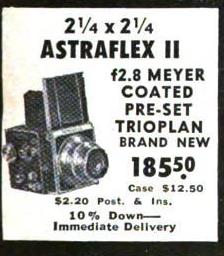
This camera ended up being sold for years afterward as the "Astraflex II" by Sterling-Howard, as shown at left from one of their advertisements.
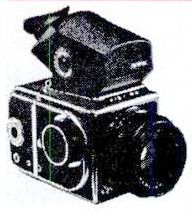
And if we're going to talk abut Hasselblad look-alikes, how can we forget the Soviet Kiev-88? However, like the Bronica, it showed originality by having a focal-plane shutter.
The same manufacturing plant in Ukraine also made, starting from 1977, the fully manual Kiev-17, and from 1985, the Kiev-19, which had through the lens metering; these two 35mm SLR cameras used the Nikon F lens mount.
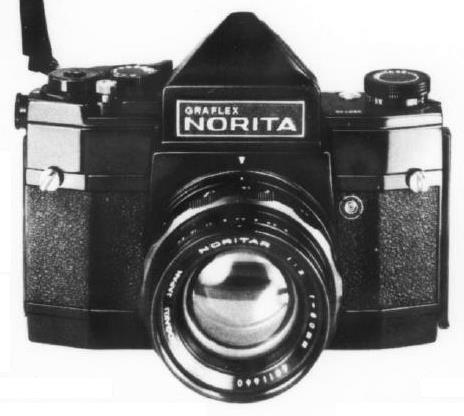
Before there was the Pentax 6x7, there was the Graflex Norita, which was also a medium format camera which resembled a 35mm SLR in appearance. It was imported from Japan by the American company Graflex, and its Japanese maker was Norita. Norita got its start making cameras by buying the assets of Musahino after it went bankrupt, and so the Optica IIa mentioned above turns out to have had more historical significance than I realized.
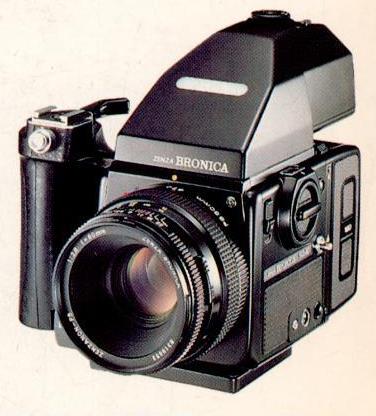
To be fair to Bronica, their camera was not a mere imitation of the Hasselblad. It offered an important choice to photographers, since unlike the Hasselblad, it had a focal-plane shutter. Which I still think is the most logical kind of shutter to have for cameras with interchangeable lenses, despite the success of the Hasselblad. However, some of the models of camera they made used leaf shutters instead.
While the focal-plane shutter is well suited to cameras with interchangeable lenses, however, for medium-format cameras as opposed to 35mm cameras, it has one disadvantage: the distance over which the shutter's elements must move during operation is larger. That may be the primary reason for leaf shutters being favored on the larger cameras.
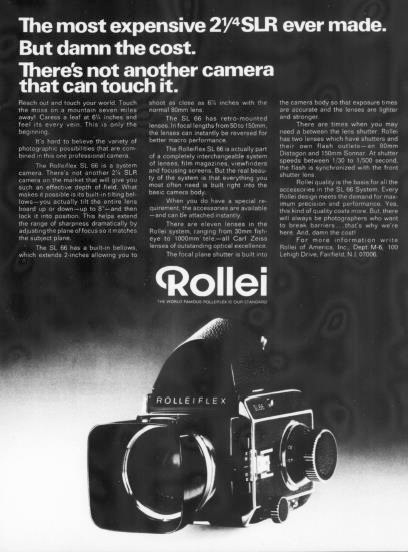
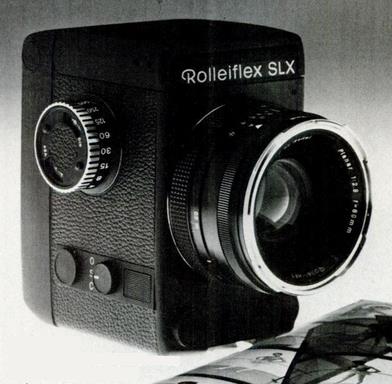
Rollei, makers of the famed Rolleiflex line of twin-lens reflex cameras, not only felt the need to join the 35mm SLR revolution with the Rolleiflex SL35 camera, as we saw earlier, but it also felt the need to come out with the Rolleiflex SL66 medium-format single-lens reflex camera.
I presume the SL in SL35 and SL66 stands for "single lens".
Since the Hasselblad was so well-established as the ideal camera for at least many significant categories of medium-format SLR users, claiming that one's new entrant into the market is not only better, but so much better that it's worth paying a higher price for it... is an uphill battle.
However, while it isn't clearly visible in the image at right, the Rolleiflex SL66 included a major feature which the Hasselblad did not have. The surface on which the lens was mounted was on a bellows, and so tilt and rotate movements were available for it, just like on a view camera. Of course, even for a number of 35mm single-lens reflex cameras, the odd lens with a limited capability of view camera-like movements built in was available, but this would have been far more flexible, if one will pardon the unavoidable pun.
Unlike the Mamiya and Bronica, the name Rolleiflex didn't immediately spring to my mind when thinking of a medium-format SLR. That is not, in itself, proof that this marketing strategy failed as resoundingly as one might fear... so let's see if Google can turn up anything.
This camera arrived on the scene in 1966, and only ceased production in 1982. But it did have a successor which was sold from 1976 to 1984, the Rolleiflex SLX, shown at right, which included automatic exposure, and that was succeeded by the Rolleiflex 6006.
However, Rollei went bankrupt in 1982; it must have subsequently resumed operation as a going concern, however. And, given the long run that the Rolleiflex SL66 had, Rollei's bankruptcy must have had other causes than this particular camera model, as it did not sell so poorly as to motivate Rollei to drop it from its product line.
From another search result, I see that initially, when the Hasselblad was impressing people favorably, and it might have appeared that the handwriting was on the wall, a gentlemen's agreement was made between Rollei and Hasselblad not to compete in each others' markets, so the SL66 only arrived after the head of Rollei had passed away. Given that the SLR was a rising star, and the twin-lens reflex a relic of the past, one could certainly conclude that this gentlemen's agreement was a poor bargain for Rollei. But given that the Rolleiflex SL66 wasn't exactly aggressively going after market share from Hasselblad the way that, say, Bronica was... it's not clear they missed out on much.
 |
The image above is from the Wikimedia Commons, licensed under the Creative Commons Attribution-Share Alike 2.0 France License, and is thus available for your use under the same terms. Its author is Rama. |
And I was pretty sure that unlike Rollei, Leica didn't attempt to make a competitor to the Hasselblad. At least, it hadn't as far as I knew about it. So I thought I'd better do a search... and my results appear to indicate that their first medium-format SLR was a digital camera rather than a film camera. So they have entered the medium-format fray at long last, but they took their time. I wonder if there was another gentlemen's agreement behind that.
Shown at right is the 37.5 megapixel Leica S2; it was succeeded by the 64 megapixel Leica S3 which was similar in appearance.
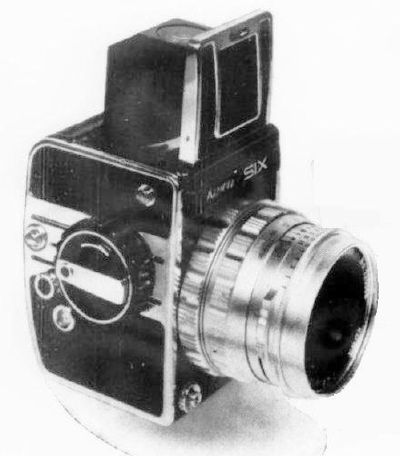
The Kowa/Six, pictured at left, succeeded by the Kowa/Six MM and then the Kowa Super 66, was another example of a medium format SLR competing for the attention of the serious photographer, starting in late 1968.
In 2004, Kowa was still making cameras, now digital; the Kowa TD-1, however, was advertised to birdwatchers, as a combination camera and spotting scope. Two lenses were offered, a 55mm lens, and a 450-1350mm zoom lens; with the latter attached, the view through the viewfinder was that of a 10x to 30x spotting scope.
Oh, and did Kodak ever make a medium-format single-lens reflex camera?
Well, perhaps... long, long ago. Back when they owned Graflex. But not otherwise. Kodak owned Graflex between 1909 and 1926. I'm not certain if they made any single-lens reflex cameras that used roll film instead of glass plates during that period, but I think that it is definitely possible.
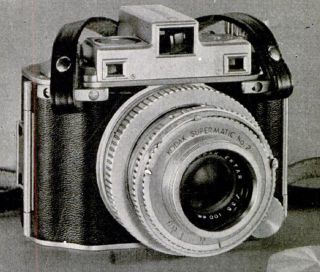
The Kodak Medalist camera is a medium format rangefinder camera by Kodak. It is of interest to mention this camera again here because it takes pictures in the 6x9 format; above we've seen cameras that take pictures in the 6x6 format, like the Hasselblad, and in the 6x7 format, such as the Pentax 6x7.
As noted on a previous page, however, and as illustrated below,

these conventional names for these three medium format frame sizes do not actually represent their real sizes accurately.
The actual sizes defined in terms of inches are in the diagram on the left, the sizes implied by the common metric names are shown in the center, and on the right the two are superimposed.
The format called 6x6 is actually 2 1/4" by 2 1/4", which is still a square format, but a bit smaller than 60 cm by 60 cm.
The format called 6x7 is actually 2 1/4" by 2 3/4", so the aspect ratio is 11:9 rather than 7:6, which means it's a bit wider than what 6x7 would imply.
The format called 6x9 is actually 2 1/4" by 3 1/4", so the aspect ratio is 13:9 rather than 3:2, making it a bit less wide than 6x9 would imply.
And these three formats are each half an inch wider than the preceding one, which is why there is no 6x8 format, since that isn't really a missing intermediate step - it's just a name skipped due to rounding.